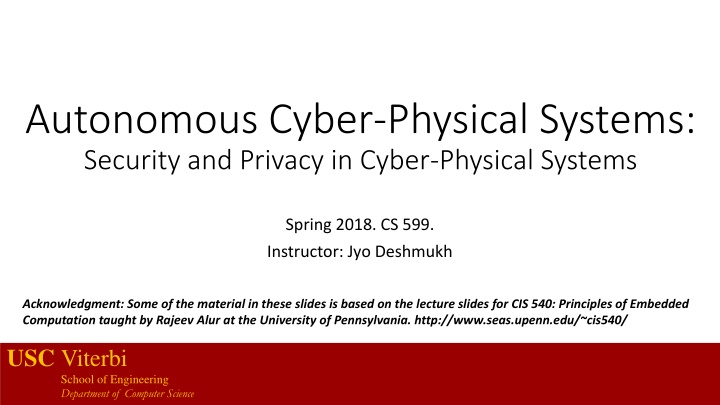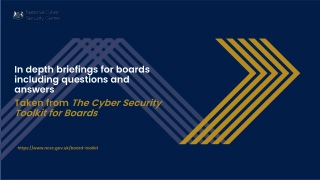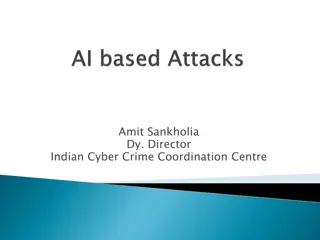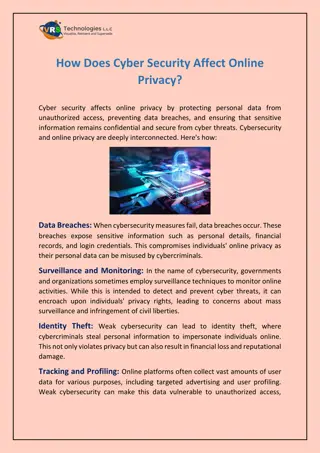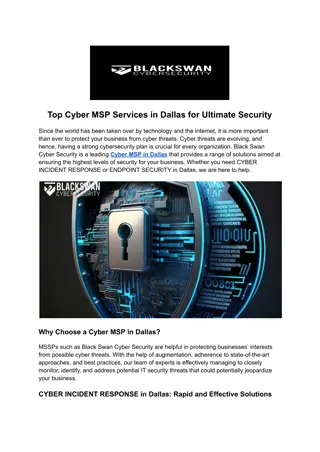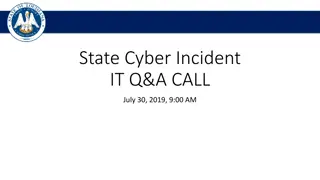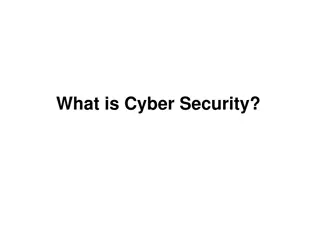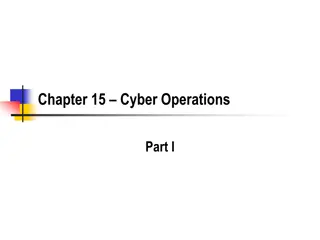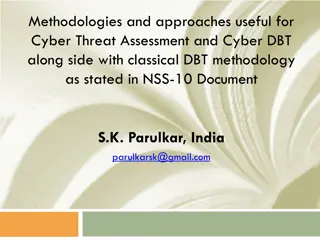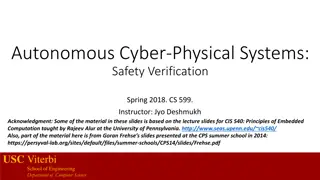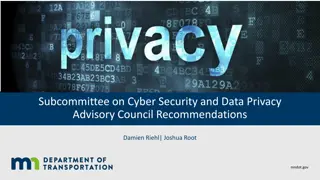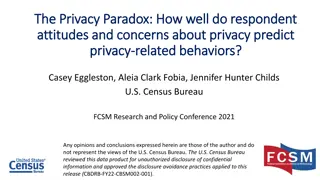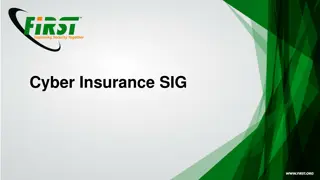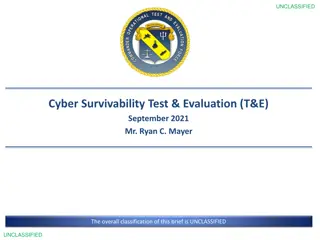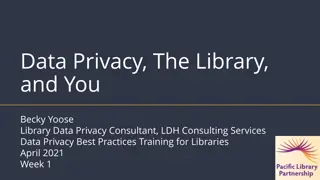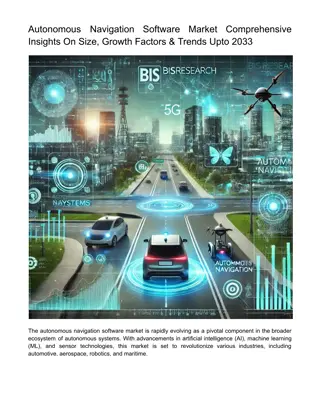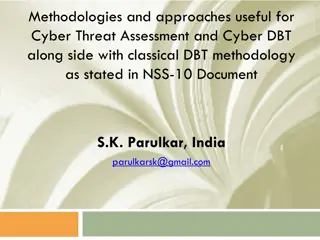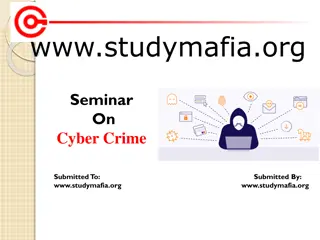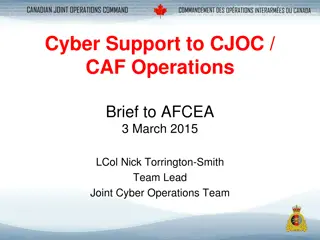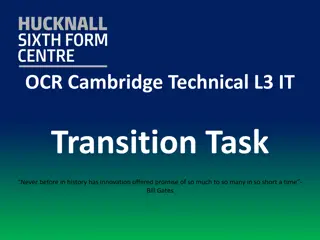Security and Privacy in Autonomous Cyber-Physical Systems
This presentation delves into the crucial aspects of security and privacy in Autonomous Cyber-Physical Systems (CPS). It covers fundamental definitions, key challenges, and solutions, emphasizing confidentiality, integrity, availability, timeliness, graceful degradation, and privacy concerns in CPS. Various scenarios are explored, highlighting the importance of maintaining trustworthiness, accessibility, and data integrity in the face of potential attacks and vulnerabilities.
Download Presentation

Please find below an Image/Link to download the presentation.
The content on the website is provided AS IS for your information and personal use only. It may not be sold, licensed, or shared on other websites without obtaining consent from the author.If you encounter any issues during the download, it is possible that the publisher has removed the file from their server.
You are allowed to download the files provided on this website for personal or commercial use, subject to the condition that they are used lawfully. All files are the property of their respective owners.
The content on the website is provided AS IS for your information and personal use only. It may not be sold, licensed, or shared on other websites without obtaining consent from the author.
E N D
Presentation Transcript
Autonomous Cyber-Physical Systems: Security and Privacy in Cyber-Physical Systems Spring 2018. CS 599. Instructor: Jyo Deshmukh Acknowledgment: Some of the material in these slides is based on the lecture slides for CIS 540: Principles of Embedded Computation taught by Rajeev Alur at the University of Pennsylvania. http://www.seas.upenn.edu/~cis540/ USC Viterbi School of Engineering Department of Computer Science
Now that you know how to design autonomous CPS Security, Privacy are must-know! USC Viterbi School of Engineering Department of Computer Science 2
Layout Basic definitions Key problems and CPS solutions to these problems USC Viterbi School of Engineering Department of Computer Science 3
Security/Privacy for Autonomous CPS Confidentiality: Ability to maintain secrecy from unauthorized users Eavesdropper should not be able to intercept and read messages sent between an Autonomous CPS agent and another agent, system or human Integrity: Trustworthiness of received data If the V2X-enabled car receives a message from the cloud indicating that there is no traffic or obstacle in the next 500 meters, is the message trustworthy? Availability: Ability of the system to be accessible Is it possible to make the self-driving car unresponsive by overwhelming its sensors with data? USC Viterbi School of Engineering Department of Computer Science 4
Security/Privacy for Autonomous CPS Timeliness: Responsiveness, how recent is the data If an adversary keeps sending messages to the UAV, can it become unresponsive to the point that its basic control abilities are compromised? Graceful Degradation: Can the system recover to successively reduced levels of operation in steps? If a sensor is compromised because of a malicious attack (e.g. an adversary flashing light into the camera, or producing fake ultrasonic pulses), can the system gracefully reach a safe state? Privacy: Preventing unwanted transfer of information (through inference or correlation) Can the self-driving car leak information about the driver s sensitive information to the infrastructure? USC Viterbi School of Engineering Department of Computer Science 5
Attacks and Attack Models Attack model: kind of access the adversary has to the system Autonomous CPS applications offer a diverse set of possible attacks Attack surface: the sum of all entry points with which the attacker can enter breach the system Sensors, actuators, communication present different kinds of attack vectors, rendering a large attack surface for an autonomous CPS CPS systems are liable to: Cyber attacks Physical attacks Cyber-Physical attacks USC Viterbi School of Engineering Department of Computer Science 6
Taxonomy of attacks Cyber attacks Network DDS Malware Exploiting software vulnerabilities: buffer overflows, code injection attacks, etc. Physical attacks Sensor spoofing Sensor jamming Timing attacks Physical damage CPS attacks Replay attacks State observation/inference Side-channel attacks Non-technical attacks (social engineering, phishing, etc.) USC Viterbi School of Engineering Department of Computer Science 7
Some interesting attacks from a CPS perspective Sensor spoofing attack: Attacker provides fake sensor data Spoofing GPS signals Present a UAV/self-driving car with a doctored image that causes perception/decision layers to behave incorrectly Physical access to sensors permits masking or subtly changing sensor signals Replay attack: Attacker intercepts insecure commands and replays them A malicious adversary could intercept messages sent in a V2X protocol, and replay the message, safe to merge when it is not safe to merge. USC Viterbi School of Engineering Department of Computer Science 8
Relevant attacks in CPS examples Sensor jamming Signals sent using DSRC will critically influence autonomous vehicle coordination and cooperation, if these signals are jammed, autonomy will suffer Timing attacks Information can be leaked by measuring the time required for a particular operation to be executed Many CPS applications use online optimization, path planning etc., and the time required to compute a decision may reveal secret information about internal state USC Viterbi School of Engineering Department of Computer Science 9
Relevant attacks in CPS Side-channel attacks These attacks involve monitoring a physical quantity such as the power consumption, electromagnetic leaks, etc. to discover secret information about the system (e.g. can be used to guess a password based on the power profile of the CPU while it is decrypting the string). Timing attacks are a subclass of side-channel attacks Information leakage/state inference By observing a CPS system, the attacker can create a state estimator for internal state of the system, which may be undesirable USC Viterbi School of Engineering Department of Computer Science 10
Themes in CPS security Attack detection Attack monitoring Secure estimation/control Privacy USC Viterbi School of Engineering Department of Computer Science 11
Attack detection Attack models: False data/Sensor spoofing attacks Replay attacks Fault data injection attacks Few main ideas: Design intrusion detection systems that detect anomalous traffic and flag alarms (for mostly cyber attacks) Construct appropriate observers that can detect and locate an attack Compute difference between estimated and measured quantities Using the state estimation Jacobian matrix Using game theoretic reasoning (attacker is player 2, system is player 1) In a networked setting: which sensors/nodes to choose for monitoring? USC Viterbi School of Engineering Department of Computer Science 12
Basic attack detection Model of a CPS under attack ? = ?(?,?) ? = ?(?,?) ?: state of the system ? : unknown disturbance Typical assumption: ?,g are linear functions described by matrices ?,?,?,? ?is generally a multi-dimensional signal attacking any number of states of the system Which states of the system are being attacked defines the attack signature USC Viterbi School of Engineering Department of Computer Science 13
Attack monitors2 Monitor is a deterministic algorithm that has access to continuous-time measurements and knowledge of system dynamics Monitor raises a flag/alarm indicating presence or absence of an attack in addition to the set of sensors being attacked An attack is detectable if the monitor raises an alarm An attack is identifiable if the monitor is able to accurately identify which states are being attacked An attack is undetectable if no monitor identifies an attack Obviously, an undetectable attack is unidentifiable USC Viterbi School of Engineering Department of Computer Science 14
Undetectable & Unidentifiable attacks Let ? and ? be two different initial states of a system. An attack ? ? is undetectable if ?: ???,? = ??0,? I.e. output seen when system starts in state ? while under attack is the same as the output seen when the system starts in state ? (when not under attack) An attack ??? is unidentifiable if ?:????,? = ????,? , where ??? is an attack that uses either a lesser number of sensors or a different set of sensors than ??? (I.e. ? ? and ? ?) Technical conditions can be derived on detectability and identifiability of attacks for linear systems USC Viterbi School of Engineering Department of Computer Science 15
Types of monitors Static monitors: verifies consistency of measurements without utilizing system dynamics or exploiting measurements taken at different times Dynamic monitors: Make use of the knowledge of system dynamics Active monitors: Injects an auxiliary input to reveal attacks Centralized vs. distributed: In a networked system, a centralized attack detector can see all nodes in the system at once and use that for attack detection (not ideal because of central point of failure) USC Viterbi School of Engineering Department of Computer Science 16
Intrusion detection using statistical techniques Assume that the observations of a process at each time follow some probability distribution (common assumption: multivariate normal distribution) Use sample mean and sample covariance to define a statistic on new observed data If the statistic shows large (or small values) then the observed data is anomalous and could indicate an attack Hotelling s?2 statistic = ?? ??? 1?? ? , where ? and ? are sample mean and covariance resp. USC Viterbi School of Engineering Department of Computer Science 17
Chi-squared detector Residue ?? of a Kalman filter: Difference between observed value and estimated value at time step ? If residues of Kalman filter are i.i.d. with mean 0 and covariance , then the ?2 detector is defined as: ? ? ??> ? ??? ??? ??= ?? ?=? ?+1 Here, ? is the size of the window over which we are interested in detecting faults USC Viterbi School of Engineering Department of Computer Science 18
Secure control3 Given dynamical system: ? = ? ?,? And a total of ? sensors monitoring the system ? = ?(?,?) Can we design a controller ? ? = ?,? 0 , ,? ? that : Makes the closed-loop system stable/exponentially stable? While facing an attack on ? sensors 1. 2. For linear systems, ? ?,? = ?? + ??,? ?,? = ?? + ?, ? = ? ? matrix USC Viterbi School of Engineering Department of Computer Science 19
Accomplishing secure control For linear systems, you can show that the system can be secured by a controller if there exists a decoder (i.e. observer) that can reconstruct the state within some number of steps Several Technical conditions for linear systems that characterize when such observers can be constructed, how many sensors can be attacked but the system withstands the attacks, etc. Several other bodies of work which utilize strategies such as : robust control, falling back to a sub-optimal controller, etc. USC Viterbi School of Engineering Department of Computer Science 20
Privacy in CPS Privacy focuses on information flow properties between systems Can my secret information flow to the adversary? Can the adversary learn my private information through my public information? Became a big issue for smart meter systems: Utility companies can infer presence or absence in the house based on the electricity consumption But, we want to share data with the utility company so that it can optimize some higher-level resource usage! CPS privacy is usually a tradeoff between marginal utility gained by sharing information vs. loss of secrecy USC Viterbi School of Engineering Department of Computer Science 21
Privacy while using the cloud Advanced encryption schemes such as partially homomorphic encryption can help share encrypted data (i.e. keeping your secrets, secret), while using a service provider like a cloud to do computationally heavy operations Key idea: define an encryption scheme ? and an operation such that ? ? ? = ? ? ?(?) Advantage: the cloud can do operations directly on the encrypted data, and send the encrypted result back. Since the ego system is the only one with the decryption key, this adds security E.g. convex optimization on the cloud4 USC Viterbi School of Engineering Department of Computer Science 22
Using logics to analyze information flow New logics such as HyperLTL and its invariants LTL: property of single traces HyperLTL: properties of sets of traces USC Viterbi School of Engineering Department of Computer Science 23
What is a hyperproperty? Logical formula that can be evaluated on two or more traces (E.g. in Hyper-LTL): ? ? G ??= ?? ?? ?? ?,? ?, ? ?,? ?, ? ?, ? Satisfying Set 1 ?, ? ?,? ?, ? ?,? ?,? ?, ? ?, ? ?, ? ?, ? ?, ? Satisfying Set 2 ?,? ?,? ?,? ?,? ?,? USC Viterbi School of Engineering Department of Computer Science 24
Examples of HyperLTL properties Observational determinism ? ? ??????= ?????? ?(???????= ??????? ) (For same inputs from low security users, we get same outputs to the low security users. Inputs from high-security users could be different) Generalized noninterference ? ? ? ? ?? ???= ?? ??? ? ?????? = ?????? ??????? = ??????? (If high inputs are the same, then if the low inputs are same, then the low outputs should be same) USC Viterbi School of Engineering Department of Computer Science 25
Applying Hyperproperties to CPS context HyperSTL! We can make predicates over signals leaking private information of a CPS to the external world In contrast to HyperLTL where decisions are Boolean, in HyperSTL, we can have any functions of the internal state of the CPS application Very new, evolving area USC Viterbi School of Engineering Department of Computer Science 26
References T. McDermott, et al., Technical Report on Human Capital Development Resilient Cyber Physical Systems, Available at: http://www.sercuarc.org/publications-papers/technical-report-human-capital-development-resilient-cyber-physical- systems/ 1. Pasqualetti, F., D rfler, F., & Bullo, F. (2013). Attack detection and identification in cyber-physical systems. IEEE Transactions on Automatic Control, 58(11), 2715-2729. 2. Paulo Tabuada s talk on science of security: http://publish.illinois.edu/science-of-security- lablet/files/2015/.../SoSCPSWeek_Tabuada.pdf 3. Shoukry, Yasser, et al. "Privacy-aware quadratic optimization using partially homomorphic encryption." Decision and Control (CDC), 2016 IEEE 55th Conference on. IEEE, 2016. 4. USC Viterbi School of Engineering Department of Computer Science 27
